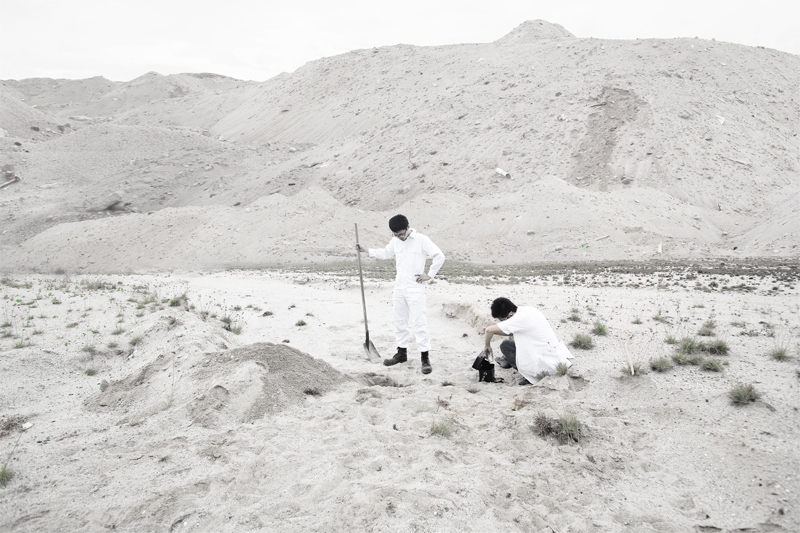GALLERY
Long Tail Paradise Crow, Day 9
Pejantan Paradise Birds, Day 21
Madura Forest & Dune Stars, Day 61
All images by the ICZ
Interview
Dr. Darrel Covman on ICZ's Discovery of New Island Species, Biodiversity, Sand dunes and a Black Geyser on Pulau Pejantan
Published on May 21 2009 in Island Biodiversity Now!, Interviews, Expedition, Organisations & logistics
© Darrel Covman
Dr. Darrel Covman of the Institute of Island Biodiversity in the Asia Pacific recently agreed to be interviewed by Island Biodiversity Now! concerning approximately 350 new tropical species that have been found on the remote island, Pulau Pejantan, off the Pacific Ocean near Indonesia during the three ICZ expeditions that took place between 2005 and 2009.
Dr. Darrel took part in all three ICZ expeditions to Pulau Pejantan and will be in charge of the access to biodiversity data that has been taken from all three expeditions. He is the Project Manager of SCPR-IarBIS (Scientific Committee on Pacific Research Island Biodiversity Information Systems)
 Sampling, Tomo and Dr. Wang Le, 2009
Sampling, Tomo and Dr. Wang Le, 2009
Day 12, Sand Sampling
Is there anything particularly special about the discovery of 350 or so new species on Pulau Pejantan?
The most important finding is the very high and rare level of biodiversity we've discovered. That's the main message from the paper. All of the taxonomical groups we worked on, we've found large numbers of species totally new to zoology. For some species, we've even discovered some new families. Each taxonomical category displayed a variable, but always significant, proportion of new species. For example, if you consider only the vertebrates we sampled, almost 50 species are new to zoology.
You had previously believed that the small islands of the Pacific had been similar in biodiversity in its region, until the findings of the ICZ expedition. Why?
I guess it's mainly because the regions we were looking at had been drastically under-sampled. Until the ICZ expedition, there had never been any major sampling efforts in the region, apart from occasional Russian expeditions. The ICZ expeditions have brought entirely new insight regarding this issue, because results have show that the actual picture is contrary to what is traditionally believed regarding the relationship between biodiversity and islands. People usually think that if you visit a few islands near each other at the same region, a repetition of biodiversity will be evident. This is actually not the case. Even if the unique biodiversity near Pulau Pejantan is lower compared to herself, there is a considerable level of diversity, especially if you take the sampling efforts of the ICZ expeditions into account, which is small compared to expeditions which have focused on the islands assemblages in Indonesia.
As Pulau Pejantan is a place of island formation in the earth's system of oceanic currents, were you able to glean any information regarding the evolutionary processes of the species inhabiting this island and how these species are related to other species living in other regions of the earth's oceans?
This is a very complex topic. We can't get a simple picture of the evolution of these animals, and a simple explanation won't fit all groups of organisms living on Pulau Pejantan. There are insects which live directly off the Black Geyser’s gushing mineral deposits and species of birds that rely heavily on the morning fog to hunt. We found that some communities, for example, have a composition similar to other island communities, while we would find the opposite in other groups. This suggests the origin of the species we sampled during the expeditions is a complex combination between the islands and the Pacific continental shelf. But it's a very complex picture we're getting, actually, and this paper is just an insight. The geographical make up of the island, one that is surrounded by dune with a semi-tropical forest in the west is something new to science as well.
How has the speciation process on Pulau Pejantan differed from comparable regions?
Pulau Pejantan is unique in being a stable system regarding the environmental conditions the fauna lives in. There is a thick fog that covers the island from morning to late afternoon and underneath the dunes are black clay and mud, which explains why the geyser is black. The organisms living there are highly adapted to living in these conditions. It is clear that these organisms have their origins on warmer regions, but they have been challenged by strong environmental stresses such as the morning fogs and sand dunes. This means that these organisms have evolved solely on the island, so only species that are able to cope with great temperature and environmental variation would be able to survive. This is a very important driver for the Pejantan species, and was actually corroborated by ICZ’s data. Another characteristic of Pulau Pejantan is the fact that the dunes surrounding its semi-tropical forest is much cooler than the beaches on other islands, allowing easier animal movement between the dunes and the forest. A few species have adapted to life in the dunes and the forest. These are two examples of the main speciation drivers in this region.
 Dark Doves, Bird Monitoring Station 26, 2009
Dark Doves, Bird Monitoring Station 26, 2009
Day 52, Pagai Dune Area
How does the island ecosystem on Pulau Pejantan compare with other island ecosystems elsewhere in the world?
Scientific interest in island ecosystems has only really started in the last three decades. Little is known about the dunes, forest and geyser of Pulau Pejantan. This ecosystem is relatively new compared to other island ecosystems elsewhere on the planet. For example, the geyser of Pulau Pejantan was formed during the opening of the Melanja Passage and tectonic movements in the Pacific Ocean. It seems that the geyser, morning fog and dunes has determined very much of the ecosystem of the island.
We were doing a research on the birds on the island, and it was just impossible to collect a specimen. Somehow, they could sense the presence of the mist nets in the fog. Bird feeders at ground level did not work as well because the birds simply could not detect it in the mist, or maybe they were not used to it. It was during the last expedition that we managed to study the birds up close, by erecting a bird feeder station of about 50 meters into the sky above the fog. We gathered that the birds on Pulau Pejantan feed high above the fog in the morning and must have evolved some form of eco-location to find their way in the mist, therefore escaping our mist nets.
Have there been any other research expeditions taking samples of other areas in Indonesia?
To my knowledge, there are a few long-term projects focusing on sites in Indonesia’s Islands and moving into process-orientated investigations. There is a dedicated initiative under the Census of Island Life (CIL) and the Census of the Diversity of Tropical Life (CEDTF) which specifically addresses the issues of island biodiversity, and similar work is going on in other islands around the world, at even more remote islands.
Copyright 2009, Institute of Critical Zoologists